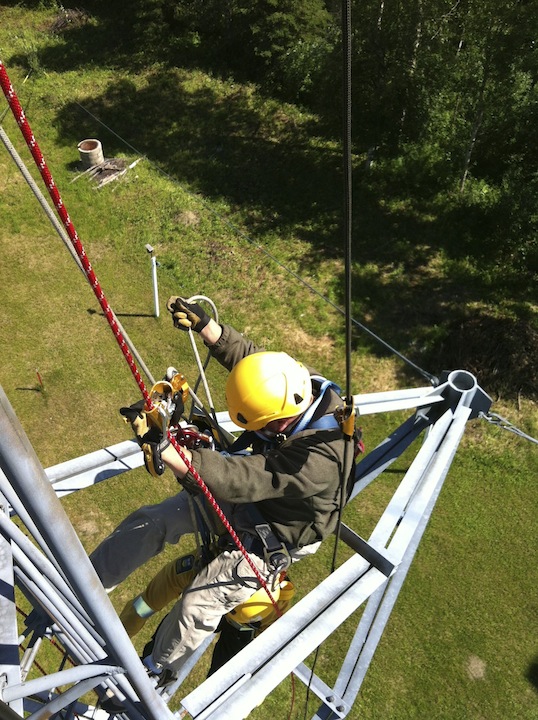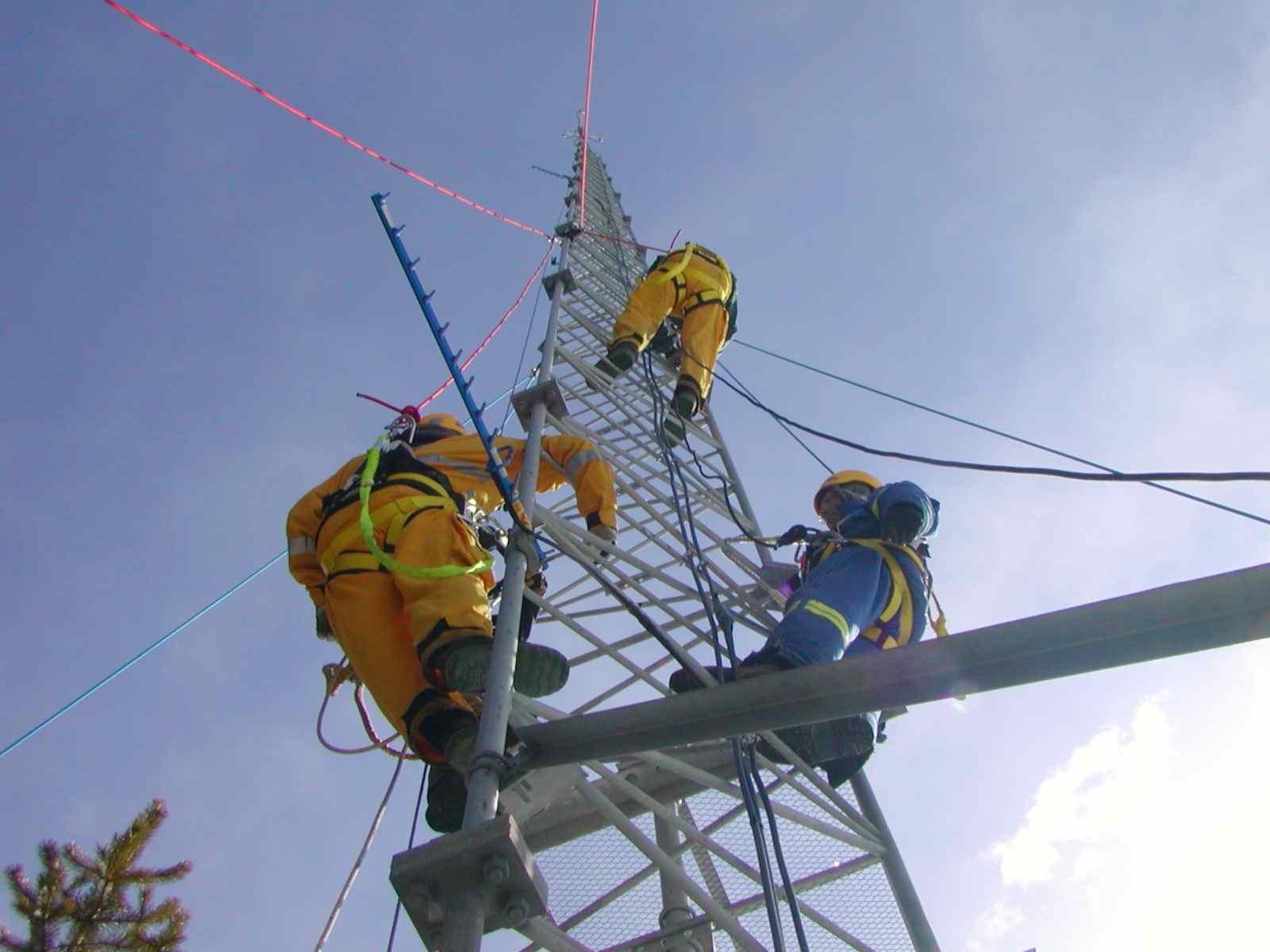Industrial fall protection and rescue are relatively new concepts. Thirty years ago in Canada climbing a tower with no protection was an accepted practice. The thought was that the worker uses three point contact, climbs until he needs a rest then straps a lineman belt or rope lanyard around the structure to rest or work. The concept of rescue was not discussed because a fall while climbing had obvious consequences.
As industry has addressed working at heights over the last decades, tower safety remains one of the last industries to adopt up to date practices. Work is generally done beyond the critical eyes of management and regulators. Tower climbers typically have a cowboy attitude that comes with the territory. As they have a high risk tolerance, they do not take criticism well and tend to manage their own safety as they see fit.
Most jurisdictions have regulations which require written assessments of fall hazards, fall protection plans and all have statements about providing rescue for a worker who could be potentially suspended from a harness. In my jurisdiction, Alberta, an employer who could end up having a worker suspended from a fall arrest system must have a written rescue plan. Although most companies are in compliance, they may not do the best job protecting the worker from injury and emergency evacuation is not necessarily effective or safe.
Although it is common to use lanyards for protection on a tower while climbing there are much safer methods. Older towers were not necessarily built with permanent fall arrest anchors in mind. They were built to support the equipment on the tower and the weight of the climbers. Retrofitting towers for ladder safety systems may be expensive or impossible given anchor strength requirements. This has made the practice of climbing the structure with a Y lanyard acceptable in the community and seen as a better practice than no protection at all. In fact climbers often prefer using a Y lanyard over a ladder safety system making excuses that the ladder safety system doesn't work smoothly or is too restrictive.
A fall with a Y lanyard on a tower would be brutal. Workers often let the anchor point stray below shoulder height which would result in a 8 or 9 foot free fall. With so much emphasis on anchor failure there is not enough recognition of injury from the fall. As the lanyard is typically on a dorsal Dee ring, a fall would thrust the worker's head forward into the tower. As most industrial workers do not use hardhats that will stay on in a fall, the head can take full contact with the structure. There is no question that a long free fall would result in serious head injuries, possibly unconsciousness which may lead to fatal consequences when compounded with suspension trauma. Any injury on a tower is a very serious rescue problem because of distances to the ground, wind, obstructions and limited manpower. To do a rescue safely and quickly after witnessing a serious injury takes thorough planning, training and practice.
Any hazard assessment would point to installing a permanent ladder safety system. A ladder safety system limits the fall to inches and the head moves away from the structure instead of towards it in a fall. When at height and the worker moves to another tower face he has to remove the ladder safety system. This shouldn't be an excuse to compromise with poor protection. The worker again should be using a fall arrest system that limits free fall to a minimum and keeps the head away from the structure in a fall. A vertical lifeline system with a short energy absorber leash attached to the sternal Dee ring would be the preferred method. Lifeline systems are available that only allow 2 foot free falls when the worker is ascending. When the worker is descending, a self trailing fall arrester stays above the worker's shoulder and the free fall is close to zero. A self trailing vertical lifeline with the appropriate rating can serve two purposes, an ideal fall arrest system for moving up and down another face as well as a lifeline for a rescue backup. To use the sternal Dee ring for fall arrest, the harness manufacturer needs to be consulted to ensure that they condone a sternal attachment.
The last key component of working at heights safety on a tower is a good positioning lanyard. A positioning lanyard not only allows the worker to free the hands to work but eliminates free falls while being used. However, a positioning lanyard that is hard to shorten quickly can be dangerous. A fall with slack in a positioning lanyard can produce forces on the hips that could cause neck and spinal injuries. The lanyard should also be able to lengthen when loaded to be more effective during use and to allow a rescuer to easily transfer the weight of the casualty to the rescue system.
As tower workers are often astute riggers, they believe they have rescue handled. It is acceptable to raise or lower equipment with rigging lines but lowering a worker with the same system is not tolerated in the rope rescue community. Tower companies will correctly point out that Occupational Health and Safety legislation does not regulate rope rescue. The regulations only demand written pre-planning or say that the rescue has to be "prompt". Just because there is no legislated minimum requirement does not mean that there is no best practice. With no guidance, safety specialists and companies do not have a way of determining whether rescue procedures are adequate, safe or follow any acceptable standards. Rescue is a rare event so well thought out planning is typically not a priority.
In truth, there are many rope rescue standards and principles developed by organizations such as NFPA, IRATA, SPRAT, ACMG, IKAR and others. Consistent themes in these standards are appropriate safe working loads, redundancy, belay competency, communication, training etc. These standards also dictate what is acceptable rescue equipment. Standards demand equipment that must be tested for rescue applications by a third party and certified to meet EN standards. An improvised rescue with a hand line and friction which has been an accepted practice for years is on its way out. If there is an incident during a rescue that is scrutinized by an expert, the findings would be harsh and unsympathetic.
These standards demand rescue equipment and anchors that have a breaking strength that is at least ten times the weight of the casualty and rescue attendant. The lowering system has a passive braking component that will engage if the rope is released by the operator. All components will absorb the additional force of a fall with slack in the rescue system.
There can be many oversights in a poorly conceived rescue system. The system must deal with the possibility of the casualty tangled in the structure. If the casualty has to be lifted before lowering there has to be a mechanical advantage system built into the rescue equipment. When the casualty is lowered, a rescuer has to descend with the casualty. Wind, long lowers or obstructions can defeat the system or cause the casualty to bounce off the tower or get hung up.
Rescue is easy to learn and easy to forget. Practical training in small groups should follow a progression so skills are learned incrementally. The worker must understand proper use and any potential problems associated with using the equipment. Once the training has been completed, a simulated rescue from a typical work location on the tower should be practiced. This practice must be repeated at intervals that will maintain or improve the level of competency achieved at the end of the training. Rescue practices need to be timed, evaluated and documented to demonstrate a continued commitment to worker safety on towers.
Let me summarize:
Fall Protection
- use systems that only permit short free falls
- use a sternal connection to keep the head away from the tower in a fall
- use head protection that will stay in place during a fall
- install ladder safety systems for climbing and descending
- use a positioning lanyard that can be adjusted easily and can be released under load
- use self trailing vertical lifelines attached to the sternal Dee ring
- document procedures and review and change the procedures as necessary
- Rescue
- use a vertical lifeline that can double as a rescue backup
- design a two rope rescue system that does not require a second rescuer
- use a rescue device that will engage if the rescuer loses control or lets go
- use equipment designed specifically for rescue and tested by a third party
- lift the casualty to untangle or release the fall arrest system before lowering
- learn a simple easy rescue system that will work in every situation
- write a rescue plan that explains all steps and anticipates any problems
- practice the rescue procedure frequently
- time the rescue and self evaluate






